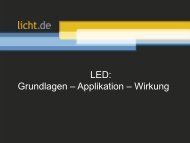licht.wissen No. 09 “Refurbishment in Trade, Commerce and Administration“
An extensive survey of offices, workshops and school classrooms shows that lots of lighting installations are obsolete. licht.wissen 09 informs that refurbishment sustainably lowers energy consumption, saves costs and makes for a significant improvement in lighting quality. This booklet from licht.de contains impartial advice for consultations with commercial clients. It also flags up web tools for assessing lighting installations and making design recommendations. Free Download at www.licht.de/en
An extensive survey of offices, workshops and school classrooms shows that lots of lighting installations are obsolete. licht.wissen 09 informs that refurbishment sustainably lowers energy consumption, saves costs and
makes for a significant improvement in lighting quality.
This booklet from licht.de contains impartial advice for consultations with commercial clients. It also flags up web tools for assessing lighting installations and making design recommendations. Free Download at www.licht.de/en
Create successful ePaper yourself
Turn your PDF publications into a flip-book with our unique Google optimized e-Paper software.
Innovative technology for human needs
Within a decade, the lighting industry has developed new technologies that are highly energy efficient and help
deliver a better quality of light. Among the most important trends in lighting are LEDs and biologically effective light,
which provides important stimuli for the human body’s internal clock of and helps make for a greater sense of
wellbeing.
[06 + 07] Biologically effective (circadian)
lighting can provide effective support for the
human body’s internal clock. It does this by
taking a leaf from daylight and dynamically
varying light colours and brightness levels:
cool light colours and high illuminance have
an activating effect; warm light colours and
low illuminance help us relax.
Indoors and out, LEDS have conquered the
realm of general lighting. No other light
source has ever worked so reliably for so
many years and at the same time required
so little electricity.
Efficient LEDs play out their advantages
mainly in complete LED luminaires and LED
modules. They have an operating life of up
to 50,000 hours or more. LEDs have an impressive
luminous efficacy and can be precisely
controlled and steplessly dimmed.
They are thus perfect for use with intelligent
lighting management systems.
LEDs: Quality pays off
The market for LED solutions is still growing
rapidly. But some products on the market
do not deliver what they promise. With
LED applications in particular, make sure
than the manufacturer offers uniform high
quality. Cut-price articles often fail to
match the performance ratings displayed
on the packaging. If lighting quality, colour
temperature, colour rendering and homogeneous
light colour are not as disclosed,
the user can be in for an unpleasant surprise
when the installation goes into operation.
Explain to your customers that although
the capital cost of a high-quality
product may be higher, it is often quickly
recouped due to far superior efficiency and
longevity.
Headway is also being made in the development
of organic light-emitting diodes
(OLEDs). OLEDs are the first truly planar
light source and produce an agreeably uniform,
glare-free light. The first models are
already on the market.
Biologically effective light
The switch to energy-efficient LED lighting
and the development of intelligent lighting
control systems are not just the key to
energy-saving lighting solutions. They also
permit lighting that has more than just
visual effects and can crucially improve
quality of life.
Current studies show that light and the natural
sequence of daylight and darkness are
triggers for many biological processes in
the human body. These non-visual effects
of light are mediated by special photoreceptors
containing the photosensitive molecule
melanopsin. Experts thus speak of
melanopic lighting.
Artificial lighting that has non-visual effects
takes its cue from daylight, supporting the
human day/night rhythm with different illuminance
levels and dynamically changing
light colours: cool white light with a high
blue content and at least 5,300 kelvin
colour temperature help sharpen our focus
in the morning, dimmed warm white light
with no more than 3,000 kelvin prepares
our body for sleep in the evening. A second
variant takes the form of “light showers”,
which briefly energise and promote concentration.
This activating light has been found
to produce positive results, for example, in
schools.
Generally speaking, the larger the visible
surface of the light source, the greater the
biological effect of its light. Lighting concepts
that extend over walls or ceilings are
thus particularly efficient. Large-format luminaires
and illuminated ceilings or pendant
luminaires that bounce some of their light
off the ceiling and upper third of the walls
are recommended options.
In schools, offices and industry, biologically
effective lighting can significantly help boost
wellbeing and motivation.
Detailed information about the LED
is found in the booklet licht.wissen 17 “LED
– The Light of the Future”; circadian lighting
is covered in licht.wissen 19 “Impact of
Light on Human Beings”.
9
















